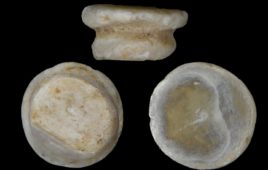This petri dish contains fossil graptolites, a group of long-extinct plankton. These particular colonies belong to the diplograptine species Geniculograptus typicalis, which floated in a shallow ocean that covered Ohio about 449 million years ago. “We don’t know much about their ecology, but their fossil record is extremely detailed,” said UChicago’s David Bapst. Photo by Lloyd DeGrane |
In
the wake of a mass extinction like the one that occurred 445 million
years ago, a common assumption is that surviving species tend to
proliferate quickly into new forms, having outlived many of their
competitors.
But
new research shows that tiny marine organisms called graptoloids did
not begin to rapidly develop new physical traits until about 2 million
years after competing species became extinct.
The
discovery challenges the idea that explosive evolution quickly follows
mass extinctions. In the absence of competition, the common theory goes,
surviving species hurry to adapt, evolving new physical attributes to
take advantage of newly opened niches in the ecosystem. But that’s not
what researchers found in the fossil record of graptoloid evolution.
“What
we found is more consistent with a different theory, which says you
might expect an evolutionary lag as the ecosystem reforms itself and new
interspecies relationships form,” said University at Buffalo geology
professor Charles E. Mitchell, who led the research.
The
research provides insight on how a new mass extinction, possibly one
resulting from man-made problems such as deforestation and climate
change, might affect life on Earth today.
A colony of Rectograptus intermedius, a diplograptine graptolite species that thrived before the Ordovician mass extinction. Graptolites were able to secret a collagen-like substance that they could then shape into tubes (each about half a millimeter wide), spines and other shapes. Paleontologists have studied fossil graptolites, which are found the world over, for more than 150 years. Courtesy of Charles Mitchell/University at Buffalo |
“How
would it affect today’s plankton? How would it affect groups of
organisms in general?” asked the paper’s lead author, David W. Bapst, a
PhD candidate at the University of Chicago, who studied with Mitchell as
an undergraduate.
“The
general motivation behind this work is understanding how extinction and
evolution of form relate to each other, and the fossil record is the
only place where we can do these sort of experiments across long spans
of time,” Bapst said.
The research on graptoloids is scheduled to appear this week in the online Early Edition of the Proceedings of the National Academy of Sciences.
Other
team members included Peter C. Bullock and Michael J. Melchin of St.
Francis Xavier University in Nova Scotia, and H. David Sheets of
Canisius College in Buffalo, N.Y. The National Science Foundation and
the Natural Sciences and Engineering Research Council of Canada
supported the study.
Research turns up unexpected results
Graptoloids
are an extinct zooplankton that lived in colonies. Because the animals
evolved quickly and had a wide geographic range, their fossil record is
rich—a trove of information on how species diversify.
Bapst,
Mitchell and their colleagues examined two different groups of
graptoloids in their study: neograptines and diplograptines. Each kind
lived during the Ordovician mass extinction that began about 445 million
years ago, but only neograptines survived.
Before
the extinction event, diplograptine species were dominant, outnumbering
neograptine species. Diplograptines also varied more in their
morphology, building colonies of many different shapes.
With
diplograptines gone after the Ordovician mass extinction, neograptines
had a chance to recover in an environment free of competitors.
According
to the popular ecological release hypothesis, these circumstances
should have led to a burst of adaptive radiation. In other words,
without competition, the neograptines should have diversified rapidly,
developing new physical traits — new colonial architectures — to take
advantage of ecological niches that the diplograptines once filled.
But that’s not what the researchers found.
Finding causes behind evolutionary lag
To
test the adaptive radiation idea, they analyzed the colony forms of 183
neograptine and diplograptine species that lived before, during or
after the Ordovician mass extinction—a total of 9 million years of
graptoloid history.
This
wealth of data enabled the team to track graptoloid evolution with more
precision than past studies could. What the researchers discovered
looked nothing like adaptive radiation.
After graptolites died, they collected at the bottom of the ocean for millions of years, becoming encased in rocks like this one. Paleontologists dissolve the rock around the graptolites to remove and examine individual colonies. This nodule contains the neogrpatine species Monograptus instrenuus, collected by Alf Lenz, University of Western Ontario. |
Almost
immediately following the Ordovician mass extinction, new neograptine
species proliferated, as expected. But according to the study, these new
species displayed only small changes in form or morphology, not the
burst of innovation the release hypothesis predicts. In fact,
graptoloids had been evolving new physical traits at a more intensive
pace before the extinction event.
Limited
morphological innovation among neograptines continued for approximately
2 million years after the extinction, Bapst said.
The
lag supports a type of evolution that argues that interactions between
co-evolving species help foster diversification. Because such
relationships likely take time to develop in a recovering ecosystem, an
evolutionary lag of the kind the graptoloid study detected should occur
in the wake of a mass extinction.
Another
possible explanation is that newly appeared graptoloid species may have
differed in ways outside of physical traits, a phenomenon that
biologists refer to as non-adaptive radiations. A third possibility is
that graptoloids may have experienced evolutionary lag due to their
complex mode of growth.
Besides
investigating how neograptines fared after the extinction event, the
team also analyzed whether colony form alone could explain why
neograptines survived the mass extinction while diplograptines
disappeared. The scientists concluded that this was unlikely, suggesting
a role for other factors such as possible differences in the preferred
habitat of the two groups.
Graptoloid diversity and disparity became decoupled during the Ordovician mass extinction







